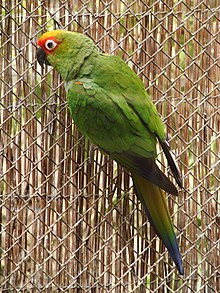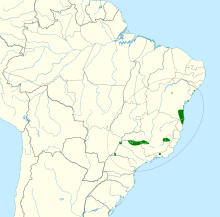300:
31:
394:’s dietary behavior is classified as frugivorous. However, the parakeets have been reported to have other food sources, including seeds, flower petals and buds, nectar, and lichens. During a 2010 to 2012 study on the eating habits of the golden-capped parakeets, the birds were noted to primarily ignore the exocarp and mesocarp or outer layers of the fruits in order to eat the seeds within. Among the food ingested by the parakeets, the researchers observed the parakeets to eat various plant materials from
84:
206:
59:
459:’ small population relatively manages to maintain its numbers. Conservation efforts targeted towards parrots and protection of its habitat have also helped slow the decline, but a continued concern over the possibility of poachers who capture exotic birds as pets and habitat loss to livestock, coffee, sugarcane, and soybean farms keeps the
361:
subspecies, golden-capped parakeets tend to populate their areas of residence within forests in groups, which can range from 4 to 15 individual parakeets. The breeding season occurs during the austral summer, which in the southern hemisphere is from
December to March, with pairs being sighted around
454:
Though observed to be in decline due to deforestation based on data recorded in affected areas, golden-capped parakeets are more commonly found outside primary forests and have a distribution of population throughout Guyana, Brazil, and
Paraguay. During a 2018 published survey of local bird species
382:
inhabits mostly the semi-deciduous forests in northeastern Brazil, although through time it has adapted to rural agricultural areas and sometimes even urban cities, spreading throughout the states of Bahia, Minas Gerais, Espírito Santo, Rio de
Janeiro, São Paolo, Goiás, and Paraná.
455:
in Minas Gerais, Brazil, golden-capped parakeets received an
Occurrence Frequency of “Frequent” throughout the region, and other surveys reporting sightings in the Chapada Diamantina National Park and the Serra de Ouricana have revealed that the
322:
The
Aratinga genus name was created to describe medium to small south American conures and parrots. As such, alongside its common name as the golden-capped parakeet, it is also called the golden-capped conure. Within the
658:
Vitorino, Breno Dias; Rodrigues, Marisa Brandão; Frota, Angélica Vilas Boas da; Avelar, Daniel
Moreira de; Rodrigues, Wellington Luiz; Castrillon, Solange Kimie Ikeda; Nunes, Josué Ribeiro da Silva (2018-04-12).
642:
Silva, Antonio P. and Melo, Celine “Foraging of the Golden-Capped
Parakeet (Aratinga Auricapillus) in the Anthropogenic Landscape in Brazil.” The Neotropical Ornithological Society. 2013.
310:
It is 30 cm (12 in) long and mostly green with a black beak, white eyerings, orange-red belly, and red face fading to yellow over the crown. Juvenile members of the
953:
314:
group develop their yellow head markings and red coloration on the lower body in adulthood. The approximate weight for golden-capped parakeets is 4.9-5.25 oz.
1033:
268:
901:
927:
1043:
625:
A New
Species of Aratinga Parakeet (Psittaciformes: Psittacidae) from Brazil, With Taxonomic Remarks on the Aratinga Solstitialis Complex
349:). Other variables such as size were found to have little variability between the two, and thus the distinction is still under question.
446:
s habitat has led to an increase in the consumption of cultivated exotic seeds and fruits including citruses, papaya, mango, and maize.
264:
582:
1053:
341:. The measured variable for this basis is slightly varied coloration between the two (less red on back and yellow on head for
932:
366:
of around 3 to 5 eggs per nesting; the incubation period for these eggs is estimated to be around 25 days, and young
958:
299:
804:
83:
818:
1048:
966:
287:
is a good biological indicator because of its vulnerability, high detectability as well as its sensitivity to
971:
839:
766:
30:
288:
178:
660:
888:
831:
48:
643:
1058:
563:
Anjos, Luiz dos (June 2007). "Efficiency of the point count method in bird richness evaluation".
213:
78:
1038:
979:
945:
862:
746:
682:
545:
395:
367:
984:
736:
672:
606:
535:
304:
844:
205:
435:
419:
330:
486:
725:"An avifaunal survey of the vanishing montane Atlantic forest of southern Bahia, Brazil"
1010:
411:
1027:
940:
701:
624:
524:"The Importance of Considering Bird Detectability for Assessing Biological Integrity"
495:
363:
195:
68:
63:
723:
Gonzaga, L. P.; Pacheco, J. F.; Bauer, C.; Castiglioni, G. D. A. (September 1995).
325:
280:
867:
854:
661:"Aves de paisagem rural na região Centro-oeste do estado de Minas Gerais, Brasil"
997:
914:
798:
248:
145:
39:
1005:
741:
724:
329:
species group, the golden-capped parakeet is the only member considered to be
276:
789:
750:
686:
549:
677:
540:
523:
427:
95:
362:
November and dependent young around March. Golden-capped parakeets have a
783:
256:
155:
115:
628:
906:
826:
272:
260:
919:
813:
623:
Luís Fábio
Silveira, Flávio César Thadeo de Lima, Elizabeth Höfling,
252:
244:
135:
105:
880:
760:
442:). In addition, the growing anthropogenic landscape surrounding the
992:
875:
403:
298:
125:
893:
764:
644:
https://sora.unm.edu/sites/default/files/ON%2024(1)%2055-66.pdf
627:, The Auk, Volume 122, Issue 1, 1 January 2005, Pages 292–305,
480:
478:
476:
370:
take around 7–8 weeks before they are able to take flight.
463:
in the least concern category on the IUCN’s red list.
583:"Golden-capped Parakeet - BirdLife Species Factsheet"
609:. World Parrot Trust (2021). Retrieved 9 March 2021.
773:
522:Bochio, Gabriela Menezes; Anjos, Luiz dos (2012).
702:"Birds of the Chapada Dimantina, Bahia, Brazil"
8:
269:subtropical or tropical moist lowland forest
761:
204:
57:
29:
20:
740:
676:
539:
472:
629:https://doi.org/10.1093/auk/122.1.292
7:
665:Neotropical Biology and Conservation
653:
651:
638:
636:
619:
617:
615:
602:
600:
1034:IUCN Red List least concern species
496:IUCN Red List of Threatened Species
337:is said to contain the subspecies
265:subtropical or tropical dry forest
14:
565:Revista Brasileira de Ornitologia
82:
729:Bird Conservation International
585:. BirdLife International (2008)
485:BirdLife International (2022).
1:
1044:Birds of the Atlantic Forest
571:: 239–243 – via ORCID.
1075:
528:Natureza & Conservação
742:10.1017/s0959270900001040
700:Parrini, Ricardo (1999).
219:
212:
203:
184:
177:
79:Scientific classification
77:
55:
46:
37:
28:
23:
1054:Birds described in 1820
678:10.4013/nbc.2018.131.08
541:10.4322/natcon.2012.012
503:: e.T22685710A209378080
24:Golden-capped parakeet
607:“Golden-capped Conure”
307:
279:. It is threatened by
235:golden-capped parakeet
1011:Aratinga-auricapillus
819:aratinga-auricapillus
805:Aratinga auricapillus
775:Aratinga auricapillus
489:Aratinga auricapillus
461:Aratinga auricapillus
457:Aratinga auricapillus
380:Aratinga auricapillus
359:Aratinga solstitialis
302:
240:Aratinga auricapillus
188:Aratinga auricapillus
289:forest fragmentation
222:Aratinga auricapilla
170:A. auricapillus
49:Conservation status
357:As members of the
308:
243:) is a species of
1021:
1020:
980:Open Tree of Life
767:Taxon identifiers
432:Pterogynes nitens
400:Guazuma Ulmifolia
231:
230:
226:
72:
1066:
1014:
1013:
1001:
1000:
988:
987:
975:
974:
962:
961:
949:
948:
936:
935:
923:
922:
910:
909:
897:
896:
884:
883:
871:
870:
858:
857:
848:
847:
835:
834:
832:58CCB2690F43662D
822:
821:
809:
808:
807:
794:
793:
792:
762:
755:
754:
744:
735:(2–3): 279–290.
720:
714:
713:
697:
691:
690:
680:
655:
646:
640:
631:
621:
610:
604:
595:
594:
592:
590:
579:
573:
572:
560:
554:
553:
543:
519:
513:
512:
510:
508:
482:
444:A. auricapillus’
436:chinaberry trees
412:silk floss trees
396:West Indian Elms
305:Jurong Bird Park
224:
208:
190:
87:
86:
66:
61:
60:
33:
21:
1074:
1073:
1069:
1068:
1067:
1065:
1064:
1063:
1049:Birds of Brazil
1024:
1023:
1022:
1017:
1009:
1004:
996:
991:
983:
978:
970:
965:
957:
952:
944:
939:
931:
926:
918:
913:
905:
900:
892:
887:
879:
874:
866:
861:
853:
851:
843:
838:
830:
825:
817:
812:
803:
802:
797:
788:
787:
782:
769:
759:
758:
722:
721:
717:
699:
698:
694:
657:
656:
649:
641:
634:
622:
613:
605:
598:
588:
586:
581:
580:
576:
562:
561:
557:
521:
520:
516:
506:
504:
484:
483:
474:
469:
452:
440:Melia azedarach
424:Psidium guajava
392:A. auricapillus
389:
376:
355:
347:A. auricapillus
343:A. a. aurifrons
339:A. a. aurifrons
335:A. auricapillus
326:A. solstitialis
320:
312:A. auricapillus
297:
285:A. auricapillus
199:
192:
186:
173:
81:
73:
62:
58:
51:
17:
16:Species of bird
12:
11:
5:
1072:
1070:
1062:
1061:
1056:
1051:
1046:
1041:
1036:
1026:
1025:
1019:
1018:
1016:
1015:
1002:
989:
976:
963:
950:
937:
924:
911:
898:
885:
872:
859:
849:
836:
823:
810:
795:
779:
777:
771:
770:
765:
757:
756:
715:
692:
647:
632:
611:
596:
574:
555:
514:
471:
470:
468:
465:
451:
448:
416:Ceiba speciosa
388:
385:
375:
372:
354:
351:
319:
316:
296:
293:
259:. Its natural
247:in the family
229:
228:
217:
216:
210:
209:
201:
200:
193:
182:
181:
175:
174:
167:
165:
161:
160:
153:
149:
148:
143:
139:
138:
136:Psittaciformes
133:
129:
128:
123:
119:
118:
113:
109:
108:
103:
99:
98:
93:
89:
88:
75:
74:
56:
53:
52:
47:
44:
43:
35:
34:
26:
25:
15:
13:
10:
9:
6:
4:
3:
2:
1071:
1060:
1057:
1055:
1052:
1050:
1047:
1045:
1042:
1040:
1037:
1035:
1032:
1031:
1029:
1012:
1007:
1003:
999:
994:
990:
986:
981:
977:
973:
968:
964:
960:
955:
951:
947:
942:
938:
934:
929:
925:
921:
916:
912:
908:
903:
899:
895:
890:
886:
882:
877:
873:
869:
864:
860:
856:
850:
846:
841:
837:
833:
828:
824:
820:
815:
811:
806:
800:
796:
791:
785:
781:
780:
778:
776:
772:
768:
763:
752:
748:
743:
738:
734:
730:
726:
719:
716:
711:
707:
703:
696:
693:
688:
684:
679:
674:
670:
666:
662:
654:
652:
648:
645:
639:
637:
633:
630:
626:
620:
618:
616:
612:
608:
603:
601:
597:
584:
578:
575:
570:
566:
559:
556:
551:
547:
542:
537:
533:
529:
525:
518:
515:
502:
498:
497:
492:
490:
481:
479:
477:
473:
466:
464:
462:
458:
449:
447:
445:
441:
437:
433:
429:
425:
421:
420:common guavas
417:
413:
409:
405:
401:
397:
393:
386:
384:
381:
373:
371:
369:
365:
360:
352:
350:
348:
345:than that of
344:
340:
336:
332:
328:
327:
317:
315:
313:
306:
301:
294:
292:
290:
286:
282:
278:
274:
270:
266:
262:
258:
254:
250:
246:
242:
241:
236:
227:
223:
218:
215:
211:
207:
202:
197:
191:
189:
183:
180:
179:Binomial name
176:
172:
171:
166:
163:
162:
159:
158:
154:
151:
150:
147:
144:
141:
140:
137:
134:
131:
130:
127:
124:
121:
120:
117:
114:
111:
110:
107:
104:
101:
100:
97:
94:
91:
90:
85:
80:
76:
70:
65:
64:Least Concern
54:
50:
45:
41:
36:
32:
27:
22:
19:
774:
732:
728:
718:
709:
705:
695:
671:(1): 62–73.
668:
664:
587:. Retrieved
577:
568:
564:
558:
534:(1): 72–76.
531:
527:
517:
505:. Retrieved
500:
494:
488:
460:
456:
453:
443:
439:
431:
423:
415:
407:
399:
391:
390:
379:
377:
358:
356:
346:
342:
338:
334:
324:
321:
311:
309:
284:
281:habitat loss
239:
238:
234:
232:
225:(Kuhl, 1820)
221:
220:
187:
185:
169:
168:
156:
18:
967:Neotropical
915:iNaturalist
799:Wikispecies
364:clutch size
295:Description
277:plantations
249:Psittacidae
146:Psittacidae
40:Wroclaw Zoo
1028:Categories
1006:Xeno-canto
467:References
428:pterogynes
368:fledglings
1059:Parakeets
751:0959-2709
687:2236-3777
589:3 January
550:1679-0073
331:polytypic
251:found in
164:Species:
102:Kingdom:
96:Eukaryota
42:, Poland
1039:Aratinga
993:Species+
946:22685710
845:22685710
840:BirdLife
784:Wikidata
712:: 86–95.
706:Continga
408:Zea mays
353:Behavior
318:Taxonomy
261:habitats
257:Paraguay
214:Synonyms
157:Aratinga
142:Family:
116:Chordata
112:Phylum:
106:Animalia
92:Domain:
69:IUCN 3.1
985:1034560
972:gocpar2
907:2479097
881:gocpar2
855:gocpar2
827:Avibase
790:Q303744
507:22 July
434:), and
374:Habitat
273:savanna
198:, 1820)
152:Genus:
132:Order:
122:Class:
67: (
959:867384
933:714044
894:311759
814:ARKive
749:
685:
548:
450:Status
283:. The
275:, and
271:, dry
253:Brazil
245:parrot
920:72522
876:eBird
852:BOW:
404:maize
998:9191
954:NCBI
941:IUCN
928:ITIS
902:GBIF
868:G65D
747:ISSN
683:ISSN
591:2009
546:ISSN
509:2022
501:2022
387:Diet
378:The
263:are
255:and
233:The
196:Kuhl
126:Aves
889:EoL
863:CoL
737:doi
673:doi
536:doi
426:),
418:),
410:),
402:),
303:At
38:At
1030::
1008::
995::
982::
969::
956::
943::
930::
917::
904::
891::
878::
865::
842::
829::
816::
801::
786::
745:.
731:.
727:.
710:11
708:.
704:.
681:.
669:13
667:.
663:.
650:^
635:^
614:^
599:^
569:15
567:.
544:.
532:10
530:.
526:.
499:.
493:.
475:^
333::
291:.
267:,
753:.
739::
733:5
689:.
675::
593:.
552:.
538::
511:.
491:"
487:"
438:(
430:(
422:(
414:(
406:(
398:(
237:(
194:(
71:)
Text is available under the Creative Commons Attribution-ShareAlike License. Additional terms may apply.


